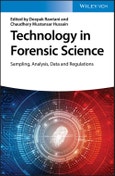Table of Contents
Preface xxi
Editor Biography xxiii
Section I Background of Forensic Science 1
1 History of Forensic Science 3
Kavya Hemanth, Maithri Tharmavaram, and Gaurav Pandey
1.1 Introduction 3
1.2 History of Origin of Forensic Science 4
1.3 History of Important Branches of Forensic Science 7
1.4 Conclusions 14
2 Conventional Technologies in Forensic Science 17
Piyush K. Rao, Maithri Tharmavaram, and Gaurav Pandey
2.1 Introduction 17
2.2 Conventional Techniques in Different Divisions of Forensic Science 19
2.3 Conclusions and Future Prospects 31
Section II Forensic Samples 35
3 Biological Evidence and Their Handling 37
Piyush K. Rao, Gaurav Pandey, and Maithri Tharmavaram
3.1 Introduction 37
3.2 Classification of the Biological Evidence 39
3.3 Preservation of Viscera and Other Body Fluids in Death due to Poisoning 42
3.4 Collection of Blood for Isolation of the DNA 44
3.5 Semen and Seminal Stains 45
3.6 Vaginal Secretions 46
3.7 Urine and Saliva 46
3.8 Tissue/Teeth/Bone Sample 46
3.9 Vomit 47
3.10 Feces 47
3.11 Sweat 47
3.12 Nasal Secretion 47
3.13 Tears and Human Milk 47
3.14 Botanical Evidence Collection and Preservation 48
3.15 Challenges Encountered 49
3.16 Future Prospects and Conclusions 50
4 Physical Evidence and Their Handling 55
Piyush K. Rao, Gaurav Pandey, and Maithri Tharmavaram
4.1 Introduction 55
4.2 Classification of Physical Evidence 56
4.3 Precautions to Be Taken While Packaging 56
4.4 Collection and Handling of Evidence 58
4.5 Conclusions 75
References 76
5 Chemical Evidences and Their Handling 79
Piyush K. Rao, Gaurav Pandey, and Maithri Tharmavaram
5.1 Introduction 79
5.2 Collection, Preservation, and Handling Methods 82
5.3 Conclusions 97
Section III Analytical Techniques for Forensic Science 101
6 Microscopy for Forensic Investigations 103
Saeida Saadat, Gaurav Pandey, and Maithri Tharmavaram
6.1 Introduction 103
6.2 The Importance of Microscope in Forensic Investigations 104
6.3 Types of Microscope Used in Forensic Sciences 107
7 Chromatographic Techniques for Forensic Investigations 129
Yogita Bhoj, Maithri Tharmavaram, Gaurav Pandey, Deepak Rawtani, and Chaudhery Mustansar Hussain
7.1 Introduction 129
7.2 Types of Chromatographic Techniques Used in Forensic Investigations 131
7.3 Applications of Chromatographic Techniques in Forensic Investigations 137
7.4 Conclusions and Future Aspects 146
8 Hyphenated Techniques for Forensic Investigations 151
Riddhi Trivedi, and Prajesh Prajapati
8.1 Introduction 151
8.2 Hyphenation and Modern Hyphenated Techniques 153
8.3 Various Applications for Forensic Investigation Using Hyphenated Techniques 160
Section IV Biometrics Technology for Forensic Science 175
9 Conventional and Emerging Biometrics Techniques in Forensic Investigations 177
Aayush Dey, Maithri Tharmavaram, Gaurav Pandey, Deepak Rawtani, and Chaudhery Mustansar Hussain
9.1 Introduction 177
9.2 Conventional Technologies in Forensic Science 178
9.3 Emerging Technologies in Forensic Science 191
9.4 Conclusions 194
Section V Sensors Technology for Forensic Science 199
10 Sensors for the Detection of Explosives and Gunshots Residues 201
Kishan Koyani, Maithri Tharmavaram, Gaurav Pandey, Deepak Rawtani, and Chaudhery Mustansar Hussain
10.1 Introduction 201
10.2 Gunshot Residues 203
10.3 Explosives 207
10.4 Conclusions 214
11 Sensors for the Detection of Illicit Drugs 221
Sejal Purohit, Gaurav Pandey, Maithri Tharmavaram, Deepak Rawtani, and Chaudhery Mustansar Hussain
11.1 Introduction 221
11.2 Illicit Drugs in Forensic Science 223
11.3 Conventional Techniques for the Detection of Illicit Drugs 225
11.4 Sensors for the Detection of Illicit Drugs 228
11.5 Conclusions 233
12 Sensors for the Detection of Biological Fluids 239
Shubhankar Dube, Maithri Tharmavaram, Gaurav Pandey, Deepak Rawtani, and Chaudhery Mustansar Hussain
12.1 Introduction 239
12.2 Biological Fluids at Crime Scenes 240
12.3 Biosensors for Biological Fluids 244
12.4 Conclusions 254
13 Sensors for Dope Tests in Sports 259
Devisree Anil, Gaurav Pandey, Maithri Tharmavaram, Deepak Rawtani, and Chaudhery Mustansar Hussain
13.1 Introduction 259
13.2 Various Drugs and Methods Used in Sports Doping 260
13.3 Conventional Techniques in Doping 263
13.4 Sensors for Dope Agent Analysis 265
13.5 Conclusions and Future Perspectives 274
Section VI Emerging Technologies in Forensic Science 279
14 Nanotechnology and Taggant Technology in Forensic Science 281
Payal V. Bhatt, Gaurav Pandey, Maithri Tharmavaram, Deepak Rawtani, and Chaudhery Mustansar Hussain
14.1 Introduction 281
14.2 Forensic Science 282
14.3 Nanotechnology 282
14.4 Taggant Technology 284
14.5 Classification of Nanomaterials and Taggants 285
14.6 Application of Nanotechnology in Forensic Science 289
14.7 Application of Taggant Technology in Forensic Science 293
14.8 Conclusions 296
Section VII Modern Perspective of Forensic Science Technologies Software 303
15 Advanced Forensic Models 305
Akshay Sharma, and Piyush K. Rao
15.1 Introduction 305
15.2 Forensic Models 306
15.3 Conclusions 321
Section VIII Ethical and Legal Issues of Forensic Science 327
16 Conventional and Internal Standards in Forensic Science 329
Rohith Krishna, and Sheetal Rajan
16.1 Introduction 329
16.2 Accreditation in Forensic Science 330
16.3 History of Forensic Science Accreditation 330
16.4 Ethics in Forensic Science 334
16.5 Standards in Forensic DNA Fingerprinting 336
16.6 Standards in Forensic Toxicology 337
16.7 Conclusions 339
Section IX Economics and Commercialization of Forensic Science Technologies 341
17 Commercialization of Regulatory Forensic Programs 343
Aakash Arora
17.1 Introduction 343
17.2 Current Landscape of Forensic Science 343
17.3 Changing World of Crime and Forensic Science 345
17.4 Challenges for Forensic Science 347
17.5 The Need for Regulatory Forensics 349
17.6 Applicability of Regulatory Forensics 352
17.7 Conclusions 353
Section X Future of Forensic Science Technologies 357
18 Future of Forensic and Crime Scene Science Technologies 359
Aakash Arora
18.1 Introduction 359
18.2 Personal Identification 359
18.3 Virtopsy 363
18.4 DNA Analysis Technology 364
18.5 Geotagging in Forensics 366
18.6 Conclusions 367
References 367
19 Concluding Notes: Future of Technology in Forensic Science 371
Deepak Rawtani, and Chaudhery Mustansar Hussain
19.1 Introduction 371
19.2 Modern Society and Forensic Science 371
19.3 Emerging Challenges for Forensic Science 372
19.4 Rereads of the Book 372
19.5 Conclusions 374
Index 375








